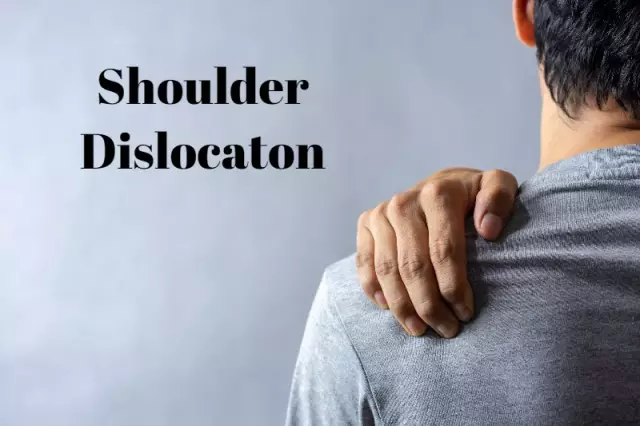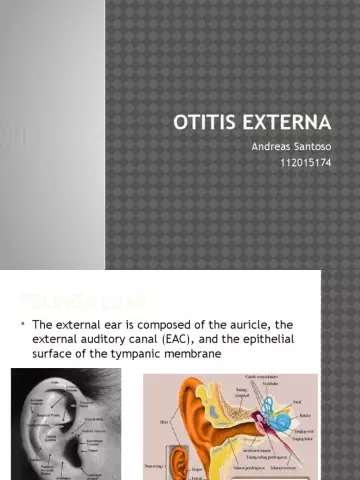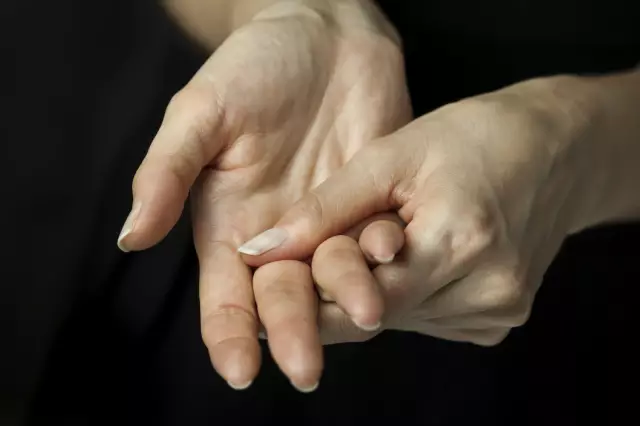- Author Rachel Wainwright [email protected].
- Public 2023-12-15 07:39.
- Last modified 2025-11-02 20:14.
Onychomycosis

Onychomycosis is a nail disease caused by a fungal infection. This pathology is very common, only 10-20% of the world's population suffers from onychomycosis. The causative agents of infection are most often dermatophytes, somewhat less often - trichophytosis, microsporia and epidermophytosis. Very often, the activity of dermatophytes is complicated by the concomitant development of yeast-like or moldy fungi, which increase the negative manifestations of the disease and cause resistance to therapy.
Epidemiology and pathogenesis
Infection with onychomycosis occurs while visiting baths, saunas, swimming pools and other public places. You can become infected with onychomycosis by touching benches, gratings, paths, carpets and any other objects on the surface of which skin flakes containing pathogenic microorganisms fall. We also note that all pathogens that cause onychomycosis not only feel great in conditions of high humidity, but also retain the ability to reproduce. Unpainted wooden surfaces are the most dangerous from the point of view of infection transmission. Often, the spread of onychomycosis occurs within the same family, when people use shared slippers, washcloths, towels, etc. Usually, the scales fall off during scratching of the affected skin.
Onychomycosis is provoked by some other factors. For example, infection more often occurs in people with circulatory disorders of the extremities, diabetes mellitus, HIV, immunodeficiency states, as well as in those patients who have previously undergone a course of corticosteroid, immunosuppressive or antibiotic therapy. Simply put, people with weakened immune systems are susceptible to this disease, so the treatment of onychomycosis must necessarily include general strengthening therapy.
Types of onychomycosis
There are three types of onychomycosis: normotrophic, hypertrophic and atrophic.
- Normotrophic onychomycosis - the nail retains its normal thickness and natural shine. Changes affect only the color of the plates, which changes color due to the appearance of stripes and spots in the lateral regions;
- Hypertrophic onychomycosis - treatment is difficult due to the increasing subcutaneous hyperkeratosis, which leads to deformation and partial destruction of the nails, as well as pain when walking. The nails become dull, lose their luster and thicken;
- Atrophic type of onychomycosis - the affected area of the nail plate acquires a brownish-gray color and atrophies over time with simultaneous rejection from the bed.
Symptoms of onychomycosis
The symptoms of onychomycosis depend on the type of disease and the severity of the clinical course. However, a number of main symptoms can be distinguished that are characteristic of all types of the disease:
- The appearance of white or yellowish spots in the thickness of the nail;
- Inflammation of the periungual fold;
- Dystrophic changes in the nail plate;
- Nail atrophy and separation from the bed.
A preliminary diagnosis is made by a dermatologist on the basis of an external examination, a clarifying diagnosis is carried out using a microscopic examination of a scraping, in some cases a bacterial culture may be required. After the diagnosis is made, treatment of onychomycosis should begin immediately, since the infection develops quite quickly and can spread, infecting the rest of the nails.
Onychomycosis - treatment of the disease
Treatment of onychomycosis in most cases begins with local antifungal therapy - ointments and creams containing antimycotics (antibiotics that can affect a fungal infection) are used. If the nail plate contains dead areas, they must be removed. Removal of the nail plate is performed either by a surgical method or with the help of special keratolytic agents that are applied to the affected surfaces, soften them and allow you to get rid of the nail almost painlessly.
Local therapy may be sufficient at an early stage of the disease; in other cases, systemic treatment is also indicated. Briefly about the most common drugs used for this purpose:
- Griseofulvin - is the first systemic antimycotic, which began to be used in the treatment of onychomycosis. It is effective in about 40% of cases, but a large number of side effects and a high percentage of relapses significantly limit its use;
- Ketoconazole - taken once a day with food. The course of treatment continues for 8-12 months. The drug cures onychomycosis in 50% of cases. The preliminary removal of the affected plates by the surgical method can increase the effectiveness of ketoconazole;
- Itraconazole is one of the most effective drugs. The course of treatment lasts 7-10 days. Positive dynamics is observed in 80-85% of patients. Unlike other products, itraconazole is quite effective even without removing damaged nail plates;
- Terbinafine - taken daily for 2-3 months. The full effect of the treatment does not appear immediately, but 48-50 weeks after the end of the course. Treatment with terbinafine allows to achieve success even in stubborn cases of the disease, with its help 80-90% of patients are cured.
All of the above drugs have serious side effects, therefore, the choice of a drug is made only by a doctor based on microbiological research data and taking into account individual contraindications. For any signs of intolerance, the drug should be discontinued and another drug should be selected.
Alternative treatment of onychomycosis
Let's make a reservation right away: if you use exclusively folk remedies, it will be very difficult to achieve a cure for onychomycosis. Traditional methods are best used as an adjunct to systemic therapy, as well as for the prevention of relapse after the completion of the main treatment. To this end, we offer you several simple recipes.
- One of the methods consists in treating the affected areas of the nail with 5% iodine solution 2 times a day. In this case, a burning sensation may be felt. If it is weak, then everything is in order - the agent produces the desired effect. If the pain is intense, then iodine treatment should be stopped;
- With onychomycosis, the beneficial effect of propolis is noted. It facilitates the passage of the infected nail and promotes the rapid growth of healthy tissue. Propolis is applied to the affected area in the form of a 20% tincture or extract;
- A well-known remedy for fighting nail fungus is a kombucha compress. To this end, they take a piece of mature kombucha and wrap it around the nail with a bandage, after thoroughly washing and steaming the legs a little. This compress is applied all night long. In the morning, it is necessary to remove the compress, rinse the nails with warm water and remove the dead areas, then treat the nail and the adjacent skin with an alcohol solution of iodine or any other antiseptic. Kombucha treatment should be continued for several weeks.
YouTube video related to the article:
The information is generalized and provided for informational purposes only. At the first sign of illness, see your doctor. Self-medication is hazardous to health!






